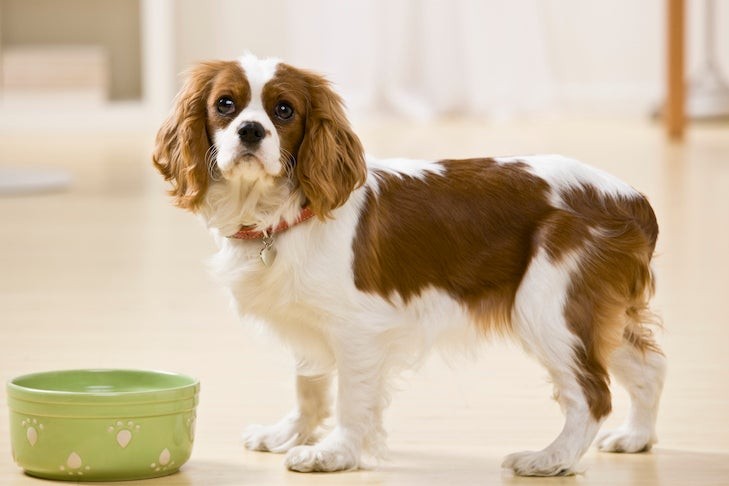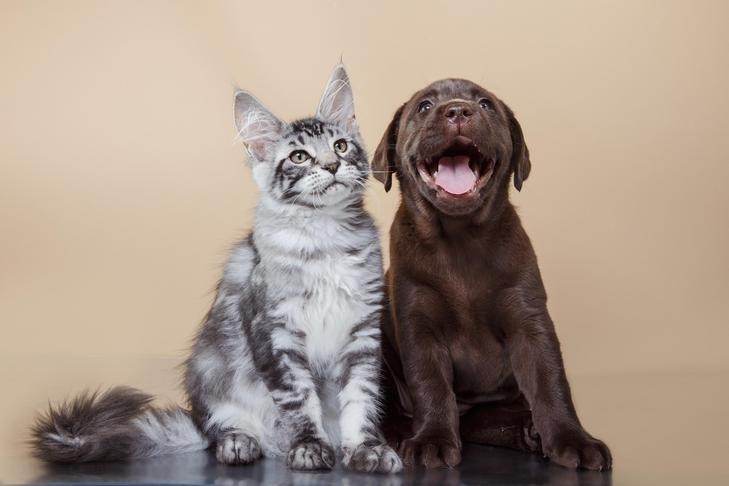Why Do Dogs Like Cat Food? This is a common question among pet owners, and FOODS.EDU.VN is here to provide a detailed explanation. Discover the reasons behind this canine craving and how to ensure your dog’s nutritional needs are met with our expert advice, tips, and guidance.
1. Understanding the Allure: Why Cat Food Appeals to Dogs
It’s a familiar scenario for many households with both canine and feline companions: your dog, with unwavering focus, attempts to sneak a bite (or more) of the cat’s food. But what is it about cat food that makes it so appealing to dogs? Several factors contribute to this interspecies culinary intrigue. Let’s examine them closely:
-
Higher Protein Content: Cats, being obligate carnivores, require a diet rich in animal protein. Cat food is formulated with this in mind, typically containing a significantly higher percentage of protein than dog food. This concentrated meat flavor and aroma are highly enticing to dogs, who are naturally drawn to protein-rich foods.
-
Stronger Flavors and Aromas: To satisfy the discerning palates of felines, cat food manufacturers often incorporate intense flavors and aromas. These potent scents, derived from animal-based ingredients, are far more pronounced than those found in typical dog food, making cat food an irresistible treat for many dogs.
-
Higher Fat Content: In addition to protein, cat food generally contains a higher fat content than dog food. Fat is a crucial energy source and contributes to the palatability of food. The rich, savory taste of fat can be particularly appealing to dogs, further driving their desire for cat food.
-
Novelty and Forbidden Fruit: Sometimes, the simple act of eating something that isn’t specifically meant for them can be a powerful motivator for dogs. The “forbidden fruit” effect, coupled with the novelty of a different flavor and texture, can make cat food seem like a particularly desirable treat.
-
Palatability Enhancers: Cat food often includes palatability enhancers, such as digests (hydrolyzed animal proteins), which are designed to make the food more appealing to cats. These enhancers also work wonders on canine taste buds, adding another layer of attraction to cat food.
2. Nutritional Differences: Cat Food vs. Dog Food
While the allure of cat food is undeniable for many dogs, it’s crucial to understand the significant nutritional differences between cat and dog food. These differences are rooted in the distinct physiological needs of each species.
-
Protein Requirements: Cats require a much higher percentage of protein in their diet than dogs. This is because cats use protein not only for building and repairing tissues but also as a primary energy source. Dog food typically contains a lower protein percentage, formulated to meet their less demanding protein needs.
-
Taurine: Taurine is an essential amino acid for cats, crucial for vision, heart function, and reproduction. Cats cannot synthesize taurine in sufficient quantities and must obtain it from their diet. Cat food is fortified with taurine, while dog food often lacks sufficient levels of this vital nutrient.
-
Arachidonic Acid: Arachidonic acid is an essential fatty acid that cats cannot produce themselves. It plays a vital role in various physiological processes. Cat food contains arachidonic acid, while dog food may not provide adequate amounts.
-
Vitamin A: Cats require preformed vitamin A (retinol) in their diet because they cannot efficiently convert beta-carotene into vitamin A. Cat food is formulated with retinol, while dog food may rely on beta-carotene, which is not effectively utilized by cats.
-
Niacin: Cats have a higher niacin requirement than dogs due to differences in their metabolic pathways. Cat food is enriched with niacin to meet these needs, while dog food may not provide sufficient levels for cats.
| Nutrient | Cat Food | Dog Food |
|---|---|---|
| Protein | Higher percentage, primarily animal-based | Lower percentage, can be plant or animal |
| Taurine | Fortified | Often lacking |
| Arachidonic Acid | Present | May be deficient |
| Vitamin A | Retinol (preformed) | Beta-carotene (less effectively utilized) |
| Niacin | Enriched | May be insufficient |



3. Potential Health Risks: Why Cat Food Isn’t Ideal for Dogs
While the occasional nibble of cat food is unlikely to cause significant harm to your dog, regularly consuming cat food can lead to various health problems due to the nutritional imbalances. Here’s a breakdown of the potential risks:
-
Obesity: The higher fat content in cat food can contribute to weight gain and obesity in dogs, especially if they are already prone to weight issues. Obesity can lead to a cascade of health problems, including joint pain, diabetes, and heart disease.
-
Gastrointestinal Upset: The rich composition of cat food can overwhelm a dog’s digestive system, leading to vomiting, diarrhea, and abdominal discomfort. This is particularly true for dogs with sensitive stomachs or those unaccustomed to high-fat diets.
-
Pancreatitis: The high fat content in cat food can trigger pancreatitis, an inflammation of the pancreas. Pancreatitis can be extremely painful and potentially life-threatening, requiring immediate veterinary intervention. Symptoms include vomiting, abdominal pain, loss of appetite, and lethargy.
-
Nutritional Imbalances: Consistently eating cat food can lead to deficiencies in essential nutrients that are adequately provided in dog food. This can result in a range of health problems, including skin issues, poor coat quality, and weakened immune function.
-
Organ Strain: The high protein levels in cat food can put extra strain on a dog’s kidneys and liver, potentially leading to long-term organ damage, especially in older dogs or those with pre-existing kidney or liver conditions.
4. Identifying the Culprit: Decoding Your Dog’s Cravings
Understanding why your dog is drawn to cat food is the first step in addressing the issue. While the inherent appeal of cat food’s taste and aroma plays a significant role, there may be other underlying factors driving your dog’s behavior. Consider these possibilities:
-
Boredom: A bored dog may seek out cat food simply for entertainment or stimulation. Providing more engaging toys, increased playtime, and regular exercise can help alleviate boredom and reduce the temptation to raid the cat’s food.
-
Anxiety: Some dogs may turn to food, including cat food, as a way to cope with anxiety or stress. Identifying and addressing the source of your dog’s anxiety, whether it’s separation anxiety, noise phobia, or social anxiety, is crucial.
-
Dietary Deficiencies: Although less common with high-quality dog foods, a dog may seek out cat food if their diet is lacking in certain nutrients. Consult with your veterinarian to ensure your dog’s food is nutritionally complete and balanced.
-
Learned Behavior: If your dog has been successful in stealing cat food in the past, they may continue to do so out of habit. Consistent training and management are essential to break this learned behavior.
-
Underlying Medical Conditions: In rare cases, a sudden increase in appetite or a craving for unusual foods could indicate an underlying medical condition. If you notice any significant changes in your dog’s eating habits, consult with your veterinarian.
5. Strategies for Prevention: Keeping Dogs Away from Cat Food
Preventing your dog from accessing cat food is essential for protecting their health and well-being. Implementing a combination of management strategies, training techniques, and environmental modifications can effectively deter your dog from indulging in this tempting treat.
-
Elevated Feeding Stations: One of the simplest and most effective methods is to place the cat’s food in a location that is inaccessible to your dog. This could involve using an elevated feeding station, a cat-only room, or a shelf that is too high for your dog to reach.
-
Controlled Feeding Times: Instead of leaving cat food out all day, establish specific feeding times for your cat. Allow your cat a designated period to eat, and then remove any remaining food. This eliminates the temptation for your dog to snack on cat food throughout the day.
-
Puzzle Feeders: For cats who tend to graze throughout the day, consider using a puzzle feeder. These feeders require cats to work for their food, slowing down their eating and preventing them from consuming large amounts at once. The slower pace can also deter dogs, who may lose interest if the food is not readily accessible.
-
Training and Obedience: Train your dog to “leave it” or “stay away” from the cat’s food bowl. Positive reinforcement techniques, such as rewarding your dog for ignoring the cat’s food, can be highly effective. Consistency and patience are key to success.
-
Supervised Feeding: Whenever your cat is eating, supervise your dog to ensure they don’t attempt to steal any food. If necessary, keep your dog on a leash or in a separate room during feeding times.
-
Pet Gates: Utilize pet gates to create barriers between your dog and the cat’s feeding area. Choose gates that are tall enough to prevent your dog from jumping over them, or opt for cat-specific gates with small openings that only cats can pass through.
-
Automatic Feeders: Automatic feeders can be programmed to dispense food at specific times, preventing the cat’s food from being constantly available. Some automatic feeders are even equipped with microchip recognition, ensuring that only the cat can access the food.
-
Environmental Enrichment: Ensure your dog has plenty of alternative activities to keep them occupied and prevent boredom-related food seeking. Provide a variety of toys, engage in regular playtime, and offer opportunities for mental stimulation.
6. Addressing Dietary Deficiencies: Ensuring Your Dog’s Nutritional Needs are Met
If you suspect that your dog’s craving for cat food may be related to dietary deficiencies, it’s crucial to address their nutritional needs with a well-balanced diet.
-
High-Quality Dog Food: Choose a dog food that is formulated with high-quality ingredients and meets the specific nutritional requirements of your dog’s age, breed, and activity level. Look for dog foods that list meat as the primary ingredient and contain a variety of essential vitamins and minerals.
-
Consult with Your Veterinarian: If you’re unsure about the best food for your dog, consult with your veterinarian. They can assess your dog’s individual needs and recommend a suitable diet.
-
Consider Adding Supplements: In some cases, your veterinarian may recommend adding supplements to your dog’s diet to address specific deficiencies. However, it’s essential to consult with a professional before adding any supplements, as excessive supplementation can also be harmful.
7. When to Seek Veterinary Advice: Recognizing the Signs of a Problem
While occasional consumption of cat food is usually not a cause for serious concern, it’s important to be aware of the potential signs of a problem and seek veterinary advice when necessary. Contact your veterinarian if your dog exhibits any of the following symptoms:
- Persistent Vomiting or Diarrhea: If your dog experiences repeated episodes of vomiting or diarrhea after eating cat food, it could indicate a gastrointestinal upset or a more serious underlying condition.
- Abdominal Pain or Discomfort: Signs of abdominal pain include a hunched posture, reluctance to move, and sensitivity to touch in the abdominal area.
- Loss of Appetite: A sudden or prolonged loss of appetite can be a sign of various health problems, including pancreatitis.
- Lethargy or Weakness: If your dog appears unusually tired or weak, it could indicate a systemic illness.
- Changes in Urination or Defecation: Changes in the frequency, amount, or consistency of urine or stool can be a sign of kidney or liver problems.
- Jaundice: Yellowing of the skin, eyes, or gums can indicate liver damage.
8. The Cat’s Perspective: Protecting Your Feline Friend’s Food
While the focus is often on preventing dogs from eating cat food, it’s equally important to protect your cat’s food from being consumed by the dog. Cats can become stressed or anxious if they feel their food is constantly being threatened.
- Create a Safe Feeding Environment: Ensure your cat has a safe, quiet, and comfortable place to eat, free from the threat of intrusion by the dog.
- Monitor Interactions: Supervise interactions between your cat and dog, especially during feeding times, to prevent any potential conflicts over food.
- Provide Enrichment: Offer your cat plenty of enrichment activities, such as scratching posts, climbing structures, and interactive toys, to reduce stress and anxiety.
9. Debunking Myths: Common Misconceptions About Dogs and Cat Food
There are several common misconceptions surrounding the topic of dogs eating cat food. Let’s debunk some of these myths:
- Myth: Cat food is poisonous to dogs.
- Fact: Cat food is not poisonous to dogs. However, it is not formulated to meet their specific nutritional needs and can lead to health problems if consumed regularly.
- Myth: A little bit of cat food won’t hurt my dog.
- Fact: While an occasional small amount of cat food is unlikely to cause significant harm, repeated consumption can lead to health issues.
- Myth: If my dog likes cat food, it means they are lacking something in their diet.
- Fact: While dietary deficiencies can sometimes contribute to cravings, the primary reason dogs like cat food is its higher protein and fat content.
- Myth: It’s okay to feed my dog cat food if they are underweight.
- Fact: While cat food may help a dog gain weight, it’s not a healthy or sustainable solution. Consult with your veterinarian about a safe and appropriate weight gain plan for your dog.
10. Finding Reliable Information: FOODS.EDU.VN as Your Trusted Resource
Navigating the world of pet nutrition can be overwhelming, with a plethora of conflicting information available online. FOODS.EDU.VN is committed to providing accurate, reliable, and up-to-date information to help you make informed decisions about your pet’s health and well-being.
- Expert-Reviewed Content: Our articles are written and reviewed by experienced veterinarians and pet nutritionists, ensuring the highest standards of accuracy and reliability.
- Comprehensive Coverage: We cover a wide range of topics related to pet nutrition, from choosing the right food to addressing specific dietary concerns.
- Easy-to-Understand Information: We present complex information in a clear, concise, and easy-to-understand manner, empowering you to make informed decisions about your pet’s health.
At FOODS.EDU.VN, we understand that your pets are family, and we are dedicated to providing you with the resources you need to keep them happy and healthy. If you want to delve deeper into the nuances of pet nutrition and discover more valuable insights, we invite you to explore the wealth of information available on our website. From detailed articles on ingredient analysis to practical tips on managing your pet’s weight, FOODS.EDU.VN is your go-to source for all things pet-related.
[Address: 1946 Campus Dr, Hyde Park, NY 12538, United States. Whatsapp: +1 845-452-9600. Website: FOODS.EDU.VN]
Ready to unlock a world of culinary wisdom and elevate your pet’s dining experience? Visit FOODS.EDU.VN today and embark on a journey of delicious discovery.
FAQ: Addressing Your Burning Questions About Dogs and Cat Food
Here are some frequently asked questions about dogs and cat food:
-
Is it okay for my dog to eat cat food occasionally?
An occasional small amount is unlikely to cause harm, but regular consumption can lead to health problems. -
What are the symptoms of pancreatitis in dogs?
Symptoms include vomiting, abdominal pain, loss of appetite, and lethargy. -
How can I prevent my dog from eating cat food?
Use elevated feeding stations, controlled feeding times, and training techniques. -
Is cat food higher in protein than dog food?
Yes, cat food typically contains a higher percentage of protein due to cats’ obligate carnivore status. -
Can dog food be harmful to cats?
Yes, dog food lacks sufficient taurine, vitamin A, and arachidonic acid, which are essential for cats. -
What should I do if my dog ate a lot of cat food?
Monitor your dog for any signs of gastrointestinal upset and contact your veterinarian if symptoms persist. -
Can boredom cause my dog to eat cat food?
Yes, boredom can lead dogs to seek out cat food for entertainment. -
Are there any health benefits of cat food for dogs?
No, there are no health benefits of cat food for dogs due to the nutritional imbalances. -
How can I ensure my dog gets all the necessary nutrients?
Feed your dog a high-quality, balanced dog food formulated for their specific needs. -
Where can I find reliable information about pet nutrition?
Visit foods.edu.vn for expert-reviewed articles and comprehensive coverage of pet nutrition topics.
